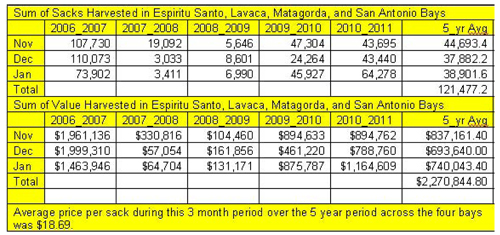Report for November 2011 through January 2012
Developed by Rhonda Cummins, Coastal & Marine Resource Advisor – Calhoun County
Relevance:
Since 1991, Texas has consistently produced the second-largest Eastern oyster crop in the United States. Texas is also considered a primary, nationwide supplier of both live oysters, products such as shucked meats available both fresh and frozen, and a variety of individually-quick-frozen (IQF) convenience products. In 2007 Texas oystermen harvested 5.6 million pounds of oyster meat that netted $19.2 million. Numbers were down in 2009 due to Hurricane Ike and the economy, but Texas still harvested 2.7 million pounds of oyster meat for which the fishermen were paid $9.4 million.
Numbers for the 2011-2012 season are expected to be drastically down because of the statewide closure of all harvesting areas. The Texas Department of State Health Services (TDSHS) depicts 33 oyster harvesting areas along the Texas Coast. The public season is normally November 1 through April 30 and during this time, bay areas may be closed by the TDSHS for concerns about public safety. Closures vary in length and in magnitude. Water testing is strictly guided and performed to monitor various harmful algal blooms, such as Karenia Brevis, a.k.a. red tide, which prompted the initial closures this season.
Response:
Extreme drought in Texas helped created high salinity conditions in the bay systems by contributing to insufficient freshwater inflows, and the lack of local rainfall, resulting in prime conditions for the massive red tide which began in late September 2011. With the oyster season unable to open for week after week, the oystermen sought assistance from elected officials and several counties wrote disaster declarations for the fishery, forwarding their proclamations to Governor Perry’s office. To assist with the body of knowledge needed to assess the economic impact to the fishermen, Texas Sea Grant Extension in Calhoun County has been working with information provided by the Texas Parks and Wildlife Department (TPWD) and local oystermen to calculate the potential economic loss at the first level of impact –sacks of oysters, and their value, landed on the local docks. This work is part of Sea Grant’s ongoing outreach and research efforts for the Texas seafood industry.
Results:
The first bay in Texas to open for harvest was San Antonio Bay’s conditionally approved area on January 27th. This area was closed four days later due to bacterial concerns related to rainfall coming down the Guadalupe River and as such is not statistically significant for the monthly total. Likewise, Espiritu Santo Bay also opened on January 27th. Due to the past number of sacks harvested from this bay over the last five years, the January landings made would be insignificant. The following figures are calculated from commercial landings data collected by TPWD over the last 5 seasons for public reefs and based on sacks sold by fishermen to processors and the value in dollars of those sacks. These data were broken down into bays by location of landings and the reasonable expected area to be fished by a captain based in that area. Oyster boats based in Calhoun County could fish any and/or all of the following bays during a week, month, or season: Espiritu Santo, Lavaca, Matagorda, and San Antonio. As such the totals of the sacks harvested and dollar value were combined by month for this assessment. Looking at the chart below, the average number of sacks landed in these four bays in the month of November was 44,693.4. The average value paid for each sack in November across the four bay area was $18.73 for a total of $837,161.40.
For the license year 2012, 110 oyster boat licenses were sold to Calhoun County residents. Since all the bays were closed, no trip tickets were filed for landings, so it is not possible to accurately determine how many boats would have been fishing if the bays were open. Thus, it is logical to use the last license year to determine possible active vessels. In the 2011 license year, 111 oyster boat licenses are sold to Calhoun County residents and 80 actually reported landings during the 2010-2011 oyster season. Therefore over the last three months, considering only active oyster boats licensed in Calhoun County, during an average year, each boat could have possibly harvested 1,518 sacks of oysters with an estimated value of $28,385.56. With the current 50 sack/day limit, the local oyster boats are working with one captain and two deckhands. The split of the day’s sale is 30% for the boat, 30% for the captain, and 20% for each deckhand, after expenses (includes oyster tags, diesel, etc.). Not considering expenses, the average losses for the first 3-month half of the 2011-2012 oyster season are $8,515.67 per vessel, $8,515.67 per captain, and $5,677.11 per deckhand.
For more information on this study, or others like it: 361-552-9747; rdcummins@ag.tamu.edu

